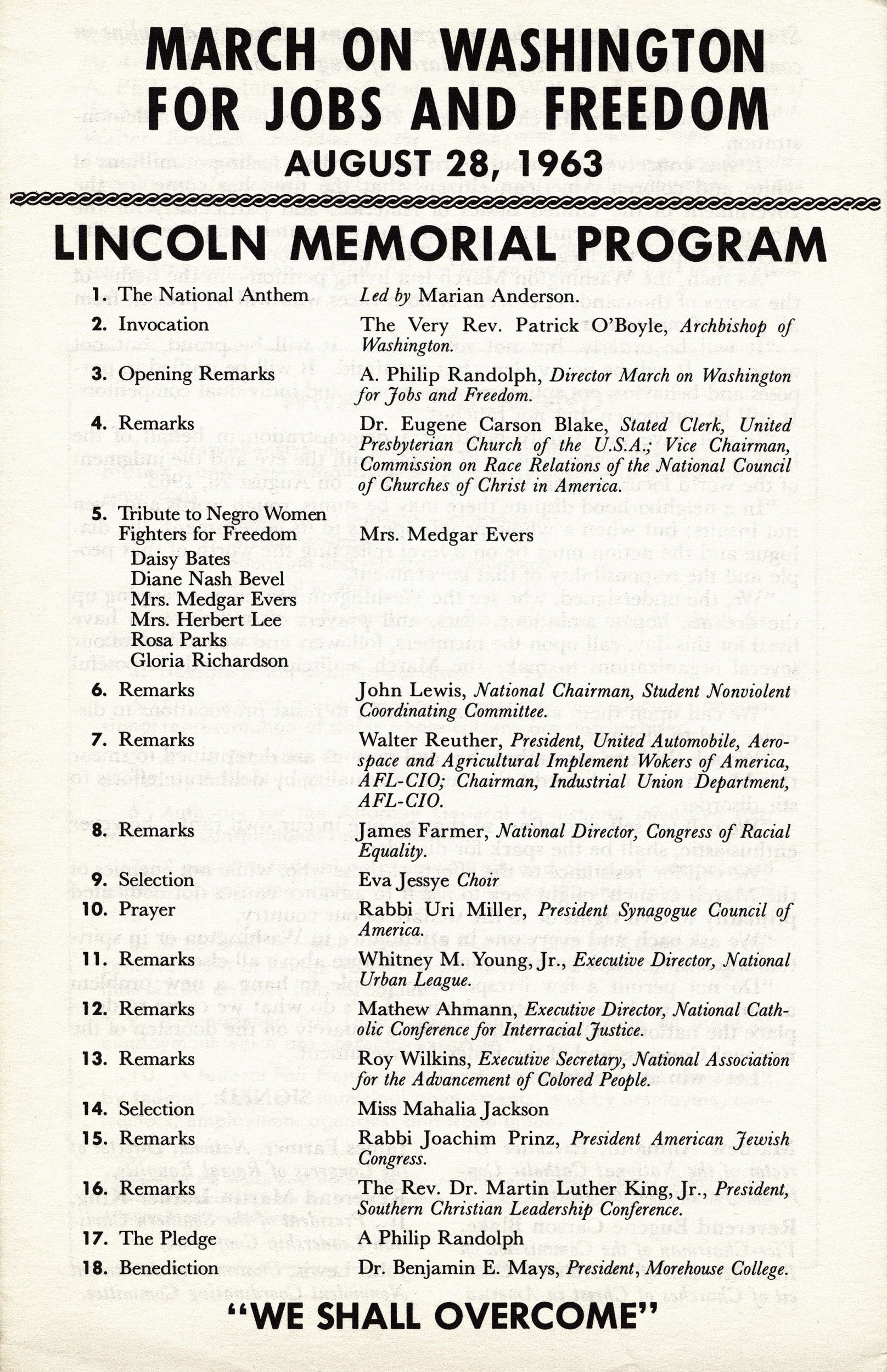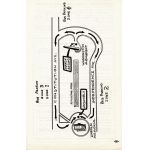Official Program for the March on Washington
8/28/1963
Add to Favorites:
Add all page(s) of this document to activity:

Add only page 1 to activity:
Add only page 2 to activity:
Add only page 3 to activity:
This program listed the events scheduled at the Lincoln Memorial during the August 28, 1963, March on Washington for Jobs and Freedom. The highlight of the march, which attracted 250,000 people, was Martin Luther King's "I Have a Dream" speech.
The idea for the 1963 March on Washington was conceived by A. Philip Randolph, a long-time civil rights activist dedicate to improving the economic condition of Black Americans. He saw the March on Washington as a great opportunity to unify all of the major civil rights organizations and improve economic opportunities.
When Randolph first proposed the march in late 1962, he received little response from other civil rights leaders. He knew that cooperation would be difficult because each had his own agenda for the civil rights movement, and the leaders competed for funding and press coverage. Success of the March on Washington would depend on the involvement of the so-called "Big Six"—Randolph and the heads of the five major civil rights organizations: Roy Wilkins of the National Association for the Advancement of Colored People (NAACP); Whitney Young, Jr., of the National Urban League; Rev. Martin Luther King, Jr., of the Southern Christian Leadership Conference (SCLC); James Farmer of the Conference of Racial Equality (CORE); and John Lewis of the Student Nonviolent Coordinating Committee (SNCC).
The details and organization of the march were handled by Bayard Rustin, Randolph’s trusted associate. Rustin was a veteran activist with extensive experience in putting together mass protests. With only two months to plan, Rustin established his headquarters in Harlem, NY, with a smaller office in Washington. He and his core staff of 200 volunteers quickly put together the largest peaceful demonstration in U.S. history.
The "Big Six" quickly spread the news through press conferences and speeches, while Rustin worked through the civil rights and labor organization to mail thousands of flyers to churches, fraternal societies, labor unions, civic groups, youth groups, and professional associations. The flyers emphasized the peaceful nature of the March and focused on the unifying goals of the Civil Rights Movement. A list of the marchers' demands included meaningful civil rights laws, full and fair employment, decent housing, the right to vote, and adequate and integrated education. Soon thousands of people sent letters to the March headquarters expressing their interest.
The idea for the 1963 March on Washington was conceived by A. Philip Randolph, a long-time civil rights activist dedicate to improving the economic condition of Black Americans. He saw the March on Washington as a great opportunity to unify all of the major civil rights organizations and improve economic opportunities.
When Randolph first proposed the march in late 1962, he received little response from other civil rights leaders. He knew that cooperation would be difficult because each had his own agenda for the civil rights movement, and the leaders competed for funding and press coverage. Success of the March on Washington would depend on the involvement of the so-called "Big Six"—Randolph and the heads of the five major civil rights organizations: Roy Wilkins of the National Association for the Advancement of Colored People (NAACP); Whitney Young, Jr., of the National Urban League; Rev. Martin Luther King, Jr., of the Southern Christian Leadership Conference (SCLC); James Farmer of the Conference of Racial Equality (CORE); and John Lewis of the Student Nonviolent Coordinating Committee (SNCC).
The details and organization of the march were handled by Bayard Rustin, Randolph’s trusted associate. Rustin was a veteran activist with extensive experience in putting together mass protests. With only two months to plan, Rustin established his headquarters in Harlem, NY, with a smaller office in Washington. He and his core staff of 200 volunteers quickly put together the largest peaceful demonstration in U.S. history.
The "Big Six" quickly spread the news through press conferences and speeches, while Rustin worked through the civil rights and labor organization to mail thousands of flyers to churches, fraternal societies, labor unions, civic groups, youth groups, and professional associations. The flyers emphasized the peaceful nature of the March and focused on the unifying goals of the Civil Rights Movement. A list of the marchers' demands included meaningful civil rights laws, full and fair employment, decent housing, the right to vote, and adequate and integrated education. Soon thousands of people sent letters to the March headquarters expressing their interest.
Transcript
[page 1]MARCH ON WASHINGTON FOR JOBS AND FREEDOM
AUGUST 28, 1963
LINCOLN MEMORIAL PROGRAM
1. The National Anthem
Led by Marian Anderson.
2. Invocation
The Very Rev. Patrick O'Boyle, Archbishop of Washington.
3. Opening Remarks
A. Philip Randolph, Director March on Washington for Jobs and Freedom.
4. Remarks
Dr. Eugene Carson Blake, Stated Clerk, United Presbyterian Church of the U.S.A.; Vice Chairman, Commission on Race Relations of the National Council of Churches of Christ in America.
5. Tribute to Negro Women Fighters for Freedom
Daisy Bates
Diane Nash Bevel
Mrs. Medgar Evers
Mrs. Herbert Lee
Rosa Parks
Gloria Richardson
Mrs. Medgar Evers
6. Remarks
John Lewis, National Chairman, Student Nonviolent Coordinating Committee.
7. Remarks
Walter Reuther, President, United Automobile, Aerospace and Agricultural Implement Workers of America, AFL-CIO; Chairman, Industrial Union Department, AFL-CIO.
8. Remarks
James Farmer, National Director, Congress of Racial Equality.
9. Selection
Eva Jessye Choir
10. Prayer
Rabbi Uri Miller, President Synagogue Council of America.
11. Remarks
Whitney M. Young, Jr., Executive Director, National Urban League.
12. Remarks
Matthew Ahmann, Executive Director, National Catholic Conference for Interracial Justice.
13. Remarks
Roy Wilkins, Executive Secretary, National Association for the Advancement of Colored People.
14. Selection
Miss Mahalia Jackson
15. Remarks
Rabbi Joachim Prinz, President American Jewish Congress.
16. Remarks
The Rev. Dr. Martin Luther King, Jr., President, Southern Christian Leadership Conference.
17. The Pledge
A. Philip Randolph
18. Benediction
Dr. Benjamin E. Mays, President, Morehouse College.
"WE SHALL OVERCOME"
This primary source comes from the Collection JFK-164: Post-Administration Records Collection.
National Archives Identifier: 5753043
Full Citation: Official Program for the March on Washington; 8/28/1963; Subject Files, 1964 - 2011; Collection JFK-164: Post-Administration Records Collection; John F. Kennedy Library, Boston, MA. [Online Version, https://www.docsteach.org/documents/document/official-program-march-on-washington, April 25, 2024]Rights: Public Domain, Free of Known Copyright Restrictions. Learn more on our privacy and legal page.






